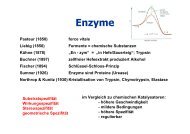Transglutaminase-1 and Bathing Suit Ichthyosis: Molecular Analysis ...
Transglutaminase-1 and Bathing Suit Ichthyosis: Molecular Analysis ...
Transglutaminase-1 and Bathing Suit Ichthyosis: Molecular Analysis ...
Create successful ePaper yourself
Turn your PDF publications into a flip-book with our unique Google optimized e-Paper software.
K Aufenvenne et al.<br />
<strong>Molecular</strong> <strong>Analysis</strong> of Gene/Environment Interactions<br />
ACKNOWLEDGMENTS<br />
This work is supported by the Selbsthilfe Ichthyose<br />
e.V. <strong>and</strong> by the Bundesministerium für Bildung<br />
und Forschung as part of the Network for Rare<br />
Diseases NIRK (GFGM01143901).<br />
Karin Aufenvenne 1 , Vinzenz Oji 1,2 ,<br />
Tatjana Walker 1 , Christoph Becker-<br />
Pauly 3 , Hans Christian Hennies 4 ,<br />
Walter Stöcker 3 <strong>and</strong> Heiko Traupe 1<br />
1 Department of Dermatology, University of<br />
Muenster, Münster, Germany; 2 University of<br />
Münster, Interdisciplinary Center of Clinical<br />
Electrostatic potential of Arg307Gly<br />
Figure 2. Comparative three-dimensional in silico modeling of the human TGase-1 structure<br />
concerning the mutations Arg307Gly (BSI) <strong>and</strong> Arg389Pro (classical LI type 1). After alignment, the<br />
molecular structure of human TGase-1 was predicted by Swiss Model (Kopp <strong>and</strong> Schwede, 2004).<br />
Modeling, energy minimization, <strong>and</strong> amino-acid substitutions were performed with DeepView SwissPDB<br />
Viewer 3.7 (Kaplan <strong>and</strong> Littlejohn, 2001) based on the structure of TGase-3 (Ahvazi et al., 2003). (a <strong>and</strong> b)<br />
Ribbon image of the model of human TGase-1 structure with Arg307 in the left panel <strong>and</strong> Arg389 in the<br />
right panel (blue). The four domains are the b-s<strong>and</strong>wich (red), the catalytic core (yellow), the b-barrel 1<br />
(blue), <strong>and</strong> b-barrel 2 (orange). The calcium ions are shown in orange. The side chains of the amino acids<br />
of the catalytic triad are drawn in ball-<strong>and</strong>-stick (red). (a) Overview of TGase-1 structure <strong>and</strong> (b) details of<br />
the ribbon image of TGase-1 show the location of the mutations Arg307 <strong>and</strong> Arg389. (c) View of the<br />
electrostatic surface potential of TGase-1 cavity surrounding residue Arg307 <strong>and</strong> Gly307. The<br />
electrostatic potentials have been mapped onto the surface plan from 15 kT (deep red) to þ 15 kT (deep<br />
blue). Arg307 is located in the core domain <strong>and</strong> hydrogen bonded to Tyr303 <strong>and</strong> Asn335. It is exposed to<br />
solvent <strong>and</strong> could possibly influence the intrinsic salvation properties of the protein. Arg389 is a highly<br />
conserved residue located in the center of the core domain of the TGase 1 peptide but buried within the<br />
molecule. An alteration of Arg389 could possibly result in an impairment of protein folding <strong>and</strong> therefore<br />
in a complete loss of activity. Arg389Pro shows no pronounced differences in electrostatic potential (data<br />
not shown).<br />
4 Journal of Investigative Dermatology<br />
Research, Münster, Germany; 3 Institute of<br />
Zoology, Johannes Gutenberg University,<br />
Mainz, Germany <strong>and</strong> 4 Cologne Center for<br />
Genomics, Division of Dermatogenetics,<br />
University of Cologne, Cologne, Germany<br />
E-mail: karin.aufenvenne@ukmuenster.de<br />
REFERENCES<br />
Ahvazi B, Boeshans KM, Idler W, Baxa U,<br />
Steinert PM (2003) Roles of calcium ions in<br />
the activation <strong>and</strong> activity of the transglutaminase<br />
3 enzyme. J Biol Chem<br />
278:23834–41<br />
Arita K, Jacyk WK, Wessagowit V, van Rensburg EJ,<br />
Chaplin T, Mein CA et al. (2007) The South<br />
African ‘‘bathing suit ichthyosis’’ is a form of<br />
lamellar ichthyosis caused by a homozygous<br />
missense mutation, p.R315L, in transglutaminase<br />
1. J Invest Dermatol 127:490–3<br />
Berson JF, Frank DW, Calvo PA, Bieler BM,<br />
Marks MS (2000) A common temperaturesensitive<br />
allelic form of human tyrosinase is<br />
retained in the endoplasmic reticulum at the<br />
nonpermissive temperature. J Biol Chem<br />
275:12281–9<br />
Boeshans KM, Mueser TC, Ahvazi B (2007) A<br />
three-dimensional model of the human<br />
transglutaminase 1: insights into the underst<strong>and</strong>ing<br />
of lamellar ichthyosis. J Mol Model<br />
13:233–46<br />
Cooper DN, Youssoufian H (1988) The CpG<br />
dinucleotide <strong>and</strong> human genetic disease.<br />
Hum Genet 78:151–5<br />
Florell SR, Meyer LJ, Boucher KM, Porter-Gill PA,<br />
Hart M, Erickson J et al. (2004) Longitudinal<br />
assessment of the nevus phenotype in a<br />
melanoma kindred. J Invest Dermatol<br />
123:576–82<br />
Giebel LB, Strunk KM, King RA, Hanifin JM,<br />
Spritz RA (1990) A frequent tyrosinase gene<br />
mutation in classic, tyrosinase-negative (type<br />
IA) oculocutaneous albinism. Proc Natl Acad<br />
Sci USA 87:3255–8<br />
Huber M, Rettler I, Bernasconi K, Frenk E,<br />
Lavrijsen SP, Ponec M et al. (1995) Mutations<br />
of keratinocyte transglutaminase in lamellar<br />
ichthyosis. Science 267:525–8<br />
Jacyk WK (2005) <strong>Bathing</strong>-suit ichthyosis. A peculiar<br />
phenotype of lamellar ichthyosis in South<br />
African blacks. Eur J Dermatol 15:433–6<br />
Kaplan W, Littlejohn TG (2001) Swiss-PDB Viewer<br />
(deep view). Brief Bioinfom 2:195–7<br />
Kopp J, Schwede T (2004) The SWEISS-MODEL<br />
repository of annotated three-dimensional<br />
protein structure homology models. Nucleic<br />
Acids Res 32:230–4<br />
Nemes Z, Marekov LN, Fesus L, Steinert PM (1999)<br />
A novel function for transglutaminase 1:<br />
attachment of long-chain omega-hydroxyceramides<br />
to involucrin by ester bond formation.<br />
Proc Natl Acad Sci USA 96:8402–7<br />
Oji V, Hautier JM, Ahvazi B, Hausser I,<br />
Aufenvenne K, Walker T et al. (2006) <strong>Bathing</strong><br />
suit ichthyosis is caused by transglutaminase-<br />
1 deficiency: evidence for a temperaturesensitive<br />
phenotype. Hum Mol Genet<br />
15:3083–97<br />
Raghunath M, Hennies HC, Ahvazi B, Vogel M,<br />
Reis A, Steinert PM et al. (2003) Self-healing<br />
collodion baby: a dynamic phenotype explained<br />
by a particular transglutaminase-1<br />
mutation. J Invest Dermatol 120:224–8<br />
Reed WB, Herwick RP, Harville D, Porter PS,<br />
Conant M (1972) Lamellar ichthyosis of the<br />
newborn. A distinct clinical entity: its comparison<br />
to the other ichthyosiform erythrodermas.<br />
Arch Dermatol 105:394–9<br />
Russell LJ, DiGiovanna JJ, Rogers GR, Steinert PM,<br />
Hashem N, Compton JG et al. (1995)<br />
Mutations in the gene for transglutaminase<br />
1 in autosomal recessive lamellar ichthyosis.<br />
Nat Genet 9:279–83




